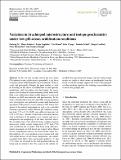Files in this item
Variation in brachiopod microstructure and isotope geochemistry under low-pH-ocean acidification conditions
Item metadata
| dc.contributor.author | Ye, Facheng | |
| dc.contributor.author | Jurikova, Hana | |
| dc.contributor.author | Angiolini, Lucia | |
| dc.contributor.author | Brand, Uwe | |
| dc.contributor.author | Crippa, Gaia | |
| dc.contributor.author | Henkel, Daniela | |
| dc.contributor.author | Laudien, Jürgen | |
| dc.contributor.author | Hiebenthal, Claas | |
| dc.contributor.author | Šmajgl, Danijela | |
| dc.date.accessioned | 2020-07-14T11:30:03Z | |
| dc.date.available | 2020-07-14T11:30:03Z | |
| dc.date.issued | 2019-02-01 | |
| dc.identifier | 269138455 | |
| dc.identifier | 9219a9b1-2549-463d-a12c-ff152f2d0750 | |
| dc.identifier | 85061062326 | |
| dc.identifier.citation | Ye , F , Jurikova , H , Angiolini , L , Brand , U , Crippa , G , Henkel , D , Laudien , J , Hiebenthal , C & Šmajgl , D 2019 , ' Variation in brachiopod microstructure and isotope geochemistry under low-pH-ocean acidification conditions ' , Biogeosciences , vol. 16 , no. 2 , pp. 617-642 . https://doi.org/10.5194/bg-16-617-2019 | en |
| dc.identifier.issn | 1726-4170 | |
| dc.identifier.uri | https://hdl.handle.net/10023/20244 | |
| dc.description | This project was supported by the European Union's Horizon 2020 research and innovation programme under Marie Skłodowska-Curie grant agreement no. 643084 (BASE–LiNE Earth). | en |
| dc.description.abstract | In the last few decades and in the near future CO2-induced ocean acidification is potentially a big threat to marine calcite-shelled animals (e.g. brachiopods, bivalves, corals and gastropods). Despite the great number of studies focusing on the effects of acidification on shell growth, metabolism, shell dissolution and shell repair, the consequences for biomineral formation remain poorly understood. Only a few studies have addressed the impact of ocean acidification on shell microstructure and geochemistry. In this study, a detailed microstructure and stable isotope geochemistry investigation was performed on nine adult brachiopod specimens of Magellania venosa (Dixon, 1789). These were grown in the natural environment as well as in controlled culturing experiments under different pH conditions (ranging from 7.35 to 8.15±0.05) over different time intervals (214 to 335 days). Details of shell microstructural features, such as thickness of the primary layer, density and size of endopunctae and morphology of the basic structural unit of the secondary layer were analysed using scanning electron microscopy. Stable isotope compositions (δ13C and δ18O) were tested from the secondary shell layer along shell ontogenetic increments in both dorsal and ventral valves. Based on our comprehensive dataset, we observed that, under low-pH conditions, M. venosa produced a more organic-rich shell with higher density of and larger endopunctae, and smaller secondary layer fibres. Also, increasingly negative δ13C and δ18O values are recorded by the shell produced during culturing and are related to the CO2 source in the culture set-up. Both the microstructural changes and the stable isotope results are similar to observations on brachiopods from the fossil record and strongly support the value of brachiopods as robust archives of proxies for studying ocean acidification events in the geologic past. | |
| dc.format.extent | 26 | |
| dc.format.extent | 12491549 | |
| dc.language.iso | eng | |
| dc.relation.ispartof | Biogeosciences | en |
| dc.subject | GE Environmental Sciences | en |
| dc.subject | Ecology, Evolution, Behavior and Systematics | en |
| dc.subject | Earth-Surface Processes | en |
| dc.subject | DAS | en |
| dc.subject | SDG 14 - Life Below Water | en |
| dc.subject.lcc | GE | en |
| dc.title | Variation in brachiopod microstructure and isotope geochemistry under low-pH-ocean acidification conditions | en |
| dc.type | Journal article | en |
| dc.contributor.institution | University of St Andrews. School of Earth & Environmental Sciences | en |
| dc.identifier.doi | https://doi.org/10.5194/bg-16-617-2019 | |
| dc.description.status | Peer reviewed | en |
This item appears in the following Collection(s)
Items in the St Andrews Research Repository are protected by copyright, with all rights reserved, unless otherwise indicated.

